A Decision Support Tool for Assessing the Impact of Climate Change on Multiple Ecosystem Services
Abstract
1. Introduction
2. Decision Support Tool Description
2.1. Conceptual Design and System Architecture
- Information management component, used mainly for handling input data for the simulations (i.e., forest inventory data, climatic data (historical and future), and management prescription data);
- Prescription generator component, used to automatically create multiple alternatives based on user-defined management options;
- External stand simulator, able to project the future states of forest stands for each management prescription and climatic scenario;
- Ecosystem services component, used to assess future ecosystem services based on the evolution of the stands;
- Visualization component, able to display input and output data in form of maps, tables, figures, and 3D scenes.
2.2. Stand Dynamics Simulation Component
2.3. Ecosystem Services Component
- provisioning (e.g., food, water, fiber, and fuel);
- regulating (e.g., climate, water, and disease regulation (pest outbreaks and pathogens));
- cultural (e.g., aesthetics, recreation, spiritual, and educational).
2.4. Visualization and Graphical User Interfaces
2.4.1. Stand Definition UI
2.4.2. Climate Change UI
- T is the annual temperature, in degrees C, at time t
- T1 is the mean annual temperature value, as assigned in the initial parameters
- B is the temperature change parameter
- C is the temperature change parameter
- t is the time elapsed, in years, since the start of the run
- P is the annual precipitation, in mm, at time t
- P1 is the annual precipitation value at the start of the run, as assigned in the plot parameters
- B is the annual precipitation change parameter
- C is and the mean annual precipitation change parameter
- t is the time elapsed, in years, since the start of the run
2.4.3. Management UI
2.4.4. Simulation
2.4.5. 2D Visualization UI
2.4.6. 3D Visualization Component
2.5. Usability Evaluation
3. Illustrative Example
3.1. Data Input
3.2. Management
3.3. Simulation Outputs
3.3.1. Overview of a Simulated Stand
3.3.2. 3D Viewer
4. Discussion and Conclusions
- Overall, I am satisfied with the ease of completing the task(s).
- Overall, I am satisfied with the amount of time it took to complete the task(s).
Author Contributions
Funding
Acknowledgments
Conflicts of Interest
References
- Duraiappah, A.K.; Naeem, S.; Agardy, T.; Ash, N.J.; Cooper, H.D.; Díaz, S.; Faith, D.P.; Mace, G.; McNeely, J.A.; Mooney, H.A.; et al. Ecosystems and Human Well-Being; Island Press: Washington, DC, USA, 2005; Volume 5, ISBN 1597260401. [Google Scholar]
- Millennium Ecosystem Assestment. Ecosystems and Human Well-Being; Island Press: Washington, DC, USA, 2005; Volume 5, ISBN 1559634022. [Google Scholar]
- Haines-Young, R.; Potschin, M. Common International Classification of Ecosystem Services (CICES) V5.1 Guidance on the Application of the Revised Structure; Fabis Consulting Ltd.: Nottingham, UK, 2018. [Google Scholar]
- Terradas, J. Forest dynamics: A broad view of the evolution of the topic, including some recent regional contributions. For. Syst. 2005, 14, 525–537. [Google Scholar] [CrossRef]
- Haines-Young, R.; Potschin, M. Common International Classification of Ecosystem Services (CICES): 2011 Update. In Proceedings of the Expert Meeting on Ecosystem Accounts, London, UK, 5–7 December 2011; pp. 1–17. [Google Scholar]
- Lee, H.; Lautenbach, S. A quantitative review of relationships between ecosystem services. Ecol. Indic. 2016, 66, 340–351. [Google Scholar] [CrossRef]
- Ruiz-Peinado, R.; Del Rio, M.; Montero, G. New models for estimating the carbon sink capacity of Spanish softwood species. For. Syst. 2011, 20, 176. [Google Scholar] [CrossRef]
- Reyer, C.P.; Bathgate, S.; Blennow, K.; Borges, J.G.; Bugmann, H.; Delzon, S.; Faias, S.P.; Garcia-Gonzalo, J.; Gardiner, B.; Gonzalez-Olabarria, J.R.; et al. Are forest disturbances amplifying or canceling out climate change-induced productivity changes in European forests? Environ. Res. Lett. 2017, 12, 034027. [Google Scholar] [CrossRef]
- Gómez-garcía, E.; Azevedo, J.C.; Pérez-rodríguez, F. Original papers A compiled project and open-source code to generate web-based forest modelling simulators. Comput. Electron. Agric. 2018, 147, 1–5. [Google Scholar] [CrossRef]
- Gordon, S.N.; Floris, A.; Boerboom, L.; Lämås, T.; Ola, L.; Nieuwenhuis, M. Studying the use of forest management decision support systems: An initial synthesis of lessons learned from case studies compiled using a semantic wiki. Scand. J. For. Res. 2013, 29, 44–55. [Google Scholar] [CrossRef]
- Barreiro, S.; Rua, J.; Tomé, M. StandsSIM-MD: A management driven forest SIMulator. For. Syst. 2016, 25. [Google Scholar] [CrossRef]
- Shifley, S.R.; He, H.S.; Lischke, H.; Wang, W.J.; Jin, W.; Gustafson, E.J.; Thompson, J.R.; Thompson, F.R.; Dijak, W.D.; Yang, J. The past and future of modeling forest dynamics: From growth and yield curves to forest landscape models. Landsc. Ecol. 2017, 32, 1307–1325. [Google Scholar] [CrossRef]
- Larocque, G.R. Ecological Forest Management Handbook, 1st ed.; Larocque, G.R., Ed.; CRC Press: Boca Raton, FL, USA, 2015. [Google Scholar]
- Lei, X.; Yu, L.; Hong, L. Forest Ecology and Management Climate-sensitive integrated stand growth model (CS-ISGM) of Changbai larch (Larix olgensis) plantations. For. Ecol. Manag. 2016, 376, 265–275. [Google Scholar] [CrossRef]
- Nadal-Sala, D.; Keenan, T.F.; Sabate, S.; Gracia, C. Forest Eco-Physiological Models: Water Use and Carbon Sequestration. In Managing Forest Esosystems: The Challenge of Climate Change; Felipe, B., Robert, J., Valerie, L., Eds.; Springer: Cham, Switzerland, 2017; pp. 81–103. [Google Scholar]
- Mäkelä, A.; Landsberg, J.; Ek, A.R.; Burk, T.E.; Ter-Mikaelian, M.; Agren, G.I.; Oliver, C.D.; Puttonen, P. Process-based models for forest ecosystem management: Current state of the art and challenges for practical implementation. Tree Physiol. 2000, 20, 289–298. [Google Scholar] [CrossRef]
- Botkin, D.B. Forest Dynamics. An Ecological Model; Oxford University Press on Demand: New York, NY, USA, 1993; ISBN 0195065557. [Google Scholar]
- Bugmann, H. A REVIEW OF FOREST GAP MODELS The description, understanding and prediction of the long-term dynamics of forest ecosystems has fascinated ecologists for a long time (cf. Clements, 1916; Watt, 1925; Gleason, 1926; Tansley, 1936; Whittaker, 1953. Clim. Chang. 2001, 51, 259–305. [Google Scholar] [CrossRef]
- Liu, J.; Ashton, P.S. Individual-based simulation models for forest succession and management. For. Ecol. Manag. 1995, 73, 157–175. [Google Scholar] [CrossRef]
- Peng, C. Understanding the role of forest simulation models in sustainable forest management. Environ. Impact Assess. Rev. 2000, 20, 481–501. [Google Scholar] [CrossRef]
- Fontes, L.; Bontemps, J.-D.; Bugmann, H.; Van Oijen, M.; Gracia, C.; Kramer, K.; Lindner, M.; Rötzer, T.; Skovsgaard, J.P. Models for supporting forest management in a changing environment. For. Syst. 2011, 3, 8. [Google Scholar] [CrossRef]
- Coates, K.D.; Boldor, M.; Hall, E.; Astrup, R. Evaluation of the Complex Stand Simulation Model SORTIE-ND for Timber Supply Review in Sub-Boreal Forests of Northern BC; Technical Report For Forest Science Program Project Y093187; BC Forest Service: Smithers, BC, Canada, 2009; pp. 1–9. [Google Scholar]
- Canham, C.D.; Coates, K.D.; Bartemucci, P.; Quaglia, S. Measurement and modeling of spatially explicit variation in light transmission through interior cedar-hemlock forests of British Columbia. Can. J. For. Res. 1999, 29, 1775–1783. [Google Scholar] [CrossRef]
- Borges, J.G.; Nordstrom, E.M.; Garcia-Gonzalo, J.; Hujala, T.; Trasobares, A. Computer-Based Tools for Supporting Forest Management. The Experience and the Expertise World-Wide; Department of Forest Resource Management, Swedish University of Agricultural Sciences: Umeå, Sweden, 2014; ISBN 978-91-576-9237-5. [Google Scholar]
- Vacik, H.; Borges, J.G.; Garcia-Gonzalo, J.; Eriksson, L.O. Decision support for the provision of ecosystem services under climate change: An editorial. Forests 2015, 6, 3212–3217. [Google Scholar] [CrossRef]
- Wikström, P.; Edenius, L.; Elfving, B.; Eriksson, L.O.; LäMåS, T.; Sonesson, J.; ÖHMAN, K.; Wallerman, J.; Waller, C.; Klintebäck, F. The Heureka Forestry Decision Support System: An Overview. Math. Comput. For. Nat. Sci. 2011, 3, 87–94. [Google Scholar]
- Reynolds, K.M. Integrated decision support for sustainable forest management in the United States: Fact or fiction? Comput. Electron. Agric. 2005, 49, 6–23. [Google Scholar] [CrossRef]
- Costanza, R.; Arge, R.; De Groot, R.; Farberk, S.; Grasso, M.; Hannon, B.; Limburg, K.; Naeem, S.; O’Neill, R.V.; Paruelo, J.; et al. The value of the world’s ecosystem services and natural capital. Nature 1997, 387, 253–260. [Google Scholar] [CrossRef]
- Binder, S.; Haight, R.G.; Polasky, S.; Warziniack, T.; Mockrin, M.H.; Deal, R.L.; Arthaud, G. Forest Service General Technical Report NRS-170 Northern Research Station Assessment and Valuation of Forest Ecosystem Services: State of the Science Review; US Department of Agriculture, Forest Service, Northern Research Station: Newtown Square, PA, USA, 2017. [Google Scholar]
- Kangas, A.; Korhonen, K.T.; Packalen, T.; Vauhkonen, J. Sources and types of uncertainties in the information on forest-related ecosystem services. For. Ecol. Manag. 2018, 427, 7–16. [Google Scholar] [CrossRef]
- Baker, P.J.; Robinson, A. Review and Comparison of Tree- and Stand-based Forest Growth Models for Potential Integration into EnSym; University of Melbourne: Victoria, Australia, 2010. [Google Scholar]
- Pretzsch, H.; Grote, R.; Reineking, B.; Rötzer, T.; Seifert, S. Models for forest ecosystem management: A European perspective. Ann. Bot. 2008, 101, 1065–1087. [Google Scholar] [CrossRef] [PubMed]
- Morán-Ordoñez, A.; Roces-Díaz, J.; Otsu, K.; Ameztegui, A.; Coll, L.; Lefevre, F.; Retana, J.; Brotons, L. The use of scenarios and models to evaluate the future of nature values and ecosystem services in complex socio-ecological systems. Reg. Environ. Chang. 2019, 19, 415–428. [Google Scholar] [CrossRef]
- Garcia-Gonzalo, J.; Bushenkov, V.; McDill, M.E.; Borges, J.G. A decision support system for assessing trade-offs between ecosystem management goals: An application in Portugal. Forests 2015, 6, 65–87. [Google Scholar] [CrossRef]
- Martell, D.L. The Optimal Rotation of a Flammable Forest Stand. Can. J. For. Res. 1980, 10, 30–34. [Google Scholar] [CrossRef]
- Reed, W.J. The effects of the risk of fire on the optimal rotation of a forest. J. Environ. Econ. Manag. 1984, 11, 180–190. [Google Scholar] [CrossRef]
- González-Olabarria, J.R.; Pukkala, T. Integrating fire risk considerations in landscape-level forest planning. For. Ecol. Manag. 2011, 261, 278–287. [Google Scholar] [CrossRef]
- González, J.R.; Palahí, M.; Pukkala, T. Integrating fire risk considerations in forest management planning in Spain—A landscape level perspective. Landsc. Ecol. 2005, 20, 957–970. [Google Scholar] [CrossRef]
- Hanewinkel, M.; Peltola, H.; Soares, P.; González-Olabarria, J.R. Recent approaches to model the risk of storm and fire to European forests and their integration into simulation and decision support tools. For. Syst. 2010, 19, 30–47. [Google Scholar]
- Gracia, C.A.; Tello, E.; Sabaté, S.; Belot, J. GOTILWA: An Integrated Model of Water Dynamics and Forest Growth. Ecol. Mediterr. Evergr. Oak For. Ecol. Stud. (Analysis Synth.) 1999, 137. [Google Scholar]
- Nute, D.; Potter, W.D.; Maier, F.; Wang, J.; Twery, M.; Rauscher, H.M.; Knopp, P.; Thomasma, S.; Dass, M.; Uchiyama, H.; et al. NED-2: An agent-based decision support system for forest ecosystem management. Environ. Model. Softw. 2004, 19, 831–843. [Google Scholar] [CrossRef]
- Python Software Foundation. Available online: https://www.python.org/ (accessed on 26 March 2019).
- Graphical User Interfaces with Tk. Available online: https://docs.python.org/3/library/tk.html (accessed on 26 March 2019).
- Lxml—Processing XML and HTML with Python. Available online: https://lxml.de (accessed on 26 March 2019).
- SORTIE-ND. Available online: http://www.sortie-nd.org/ (accessed on 11 October 2018).
- W3DOM. Available online: https://www.x3dom.org/ (accessed on 12 December 2018).
- Canham, C.D.; Murphy, L.E.; Papaik, M. SORTIE-ND: Software for Spatialy-Explicit Simulation of Forest Dynamics; Cary Institute of Ecosystem Studies: Millbrook, NY, USA, 2005. [Google Scholar]
- Pacala, S.W.; Canham, C.D.; Silander, J.A., Jr. Forest models defined by field measurements: I. The design of a northeastern forest simulator. Can. J. For. Res. 1993, 23, 1980–1988. [Google Scholar] [CrossRef]
- Ameztegui, A.; Coll, L.; Messier, C. Modelling the effect of climate-induced changes in recruitment and juvenile growth on mixed-forest dynamics: The case of montane—Subalpine Pyrenean ecotones. Ecol. Model. 2015, 313, 84–93. [Google Scholar] [CrossRef]
- Bose, A.K.; Harvey, B.D.; Coates, K.D.; Brais, S.; Bergeron, Y. Modelling stand development after partial harvesting in boreal mixedwoods of eastern Canada. Ecol. Model. 2015, 300, 123–136. [Google Scholar] [CrossRef]
- Ameztegui, A.; Cabon, A.; De Cáceres, M.; Coll, L. Managing stand density to enhance the adaptability of Scots pine stands to climate change: A modelling approach. Ecol. Model. 2017, 356, 141–150. [Google Scholar] [CrossRef]
- Ameztegui, A.; Paquette, A.; Shipley, B.; Heym, M.; Messier, C.; Gravel, D. Shade tolerance and the functional trait—Demography relationship in temperate and boreal forests. Funct. Ecol. 2017, 31, 821–830. [Google Scholar] [CrossRef]
- Thorsen, B.J.; Mavsar, R.; Tyrväinen, L. The Provision of Forest Ecosystem Services Volume I: Quantifying and valuing What Science Can Tell Us; Prokofieva, I., Stenger, A., Eds.; European Forest Institute: Joensuu, Finland, 2014; Volume I, ISBN 9789525980127. [Google Scholar]
- Borràs, A.; Gené, J. Guia de la fusta de les espècies forestals de Catalunya; Catalan Institute of Wood: Solsona, Spain, 2012. [Google Scholar]
- De Miguel, S.; Bonet, J.; Pukkala, T.; De Aragón, J. Impact of forest management intensity on landscape-level mushroom productivity: A regional model-based scenario analysis. For. Ecol. Manag. 2014, 330, 218–227. [Google Scholar] [CrossRef]
- Martín-Alcón, S.; González-Olabarria, J.R.; Coll, L. Wind and snow damage in the Pyrenees pine forests: Effect of stand attributes and location. Silva Fenn. 2010, 44.3, 399–410. [Google Scholar] [CrossRef]
- Selkimäki, M.; González-Olabarria, J.R.; Pukkala, T. Site and stand characteristics related to surface erosion occurrence in forests of Catalonia (Spain). Eur. J. For. Res. 2012, 131, 727–738. [Google Scholar] [CrossRef]
- Blasco, E.; González-Olabarria, J.R.; Rodriguéz-Veiga, P.; Pukkala, T.; Kolehmainen, O.; Palahí, M. Predicting scenic beauty of forest stands in Catalonia (North-east Spain). J. For. Res. 2009, 20, 73–78. [Google Scholar] [CrossRef]
- Solano, J.-M.; Fernández, J.; Palahí, M.; Pukkala, T.; Prokofieva, I. Es rentable la gestion forestal en Cataluña? Economistas 2007, 25, 116–124. [Google Scholar]
- Coll, L.; González-Olabarria, J.R.; Mola-Yudego, B.; Pukkala, T.; Messier, C. Predicting understory maximum shrubs cover using altitude and overstory basal area in different Mediterranean forests. Eur. J. For. Res. 2011, 130, 55–65. [Google Scholar] [CrossRef]
- Web 3D Consortium. Available online: http://www.web3d.org/ (accessed on 14 December 2018).
- Brooke, J. SUS—A quick and dirty usability scale. Usability Eval. Ind. 1996, 189, 4–7. [Google Scholar]
- Lewis, J. The System Usability Scale: Past, Present, and Future. Int. J. Hum. Comput. Interact. 2018, 34, 577–590. [Google Scholar] [CrossRef]
- Tullis, T.; Stetson, J. A Comparison of Questionnaires for Assessing Website Usability. In Proceedings of the Usability Professional Association Conference, Minneapolis, MN, USA, 7–11 June 2004. [Google Scholar]
- Lewis, J.R. IBM Computer Usability Satisfaction Questionnaires: Psychometric Evaluation and Instructions for Use. Int. J. Hum. Comput. Interact. 1995, 7, 57–78. [Google Scholar] [CrossRef]
- De Caceres, M.; Martin-StPaul, N.; Turco, M.; Cabon, A.; Granda, V. Estimating daily meteorological data and downscaling climate models over landscapes. Environ. Model. Softw. 2018, 108, 186–196. [Google Scholar] [CrossRef]

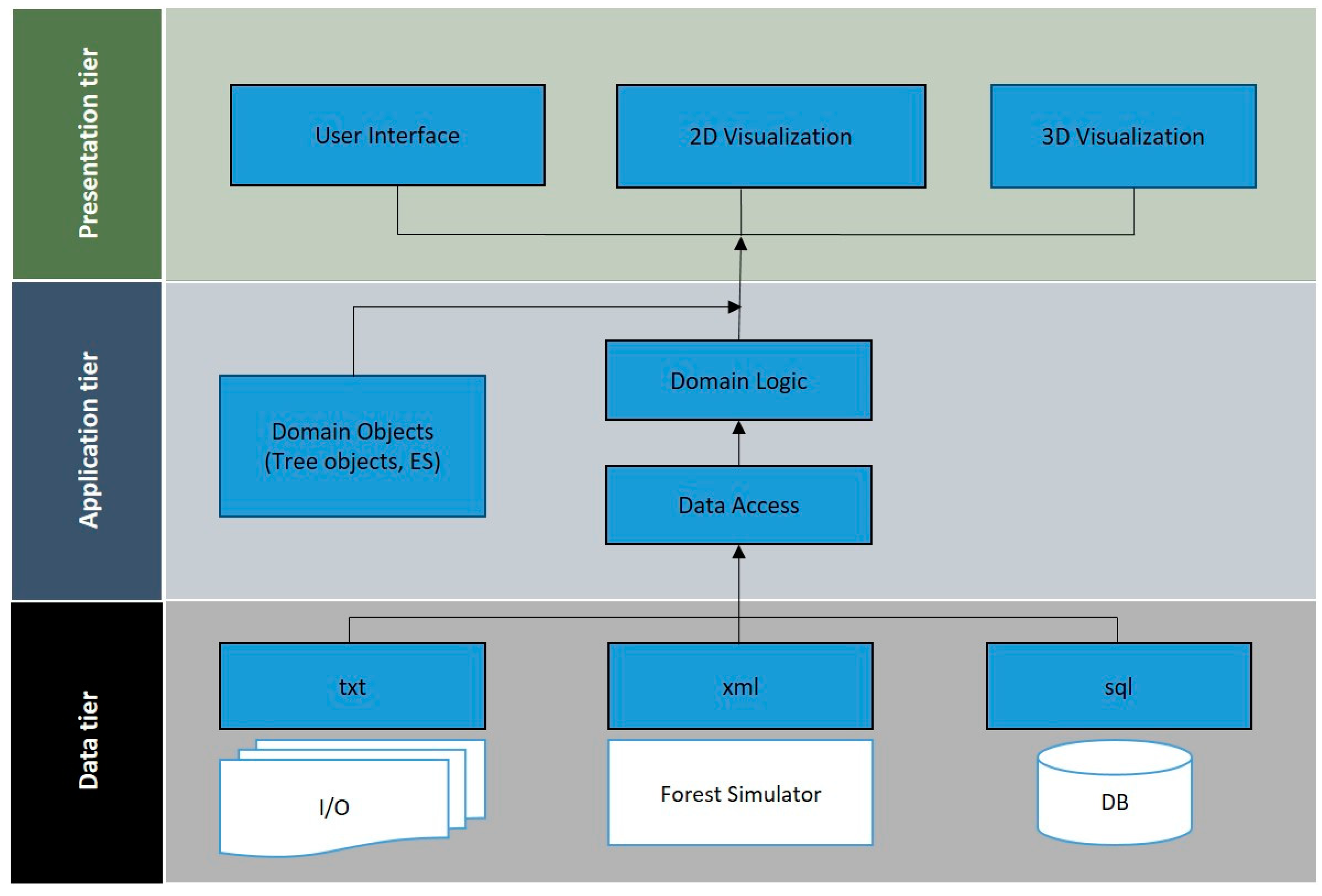
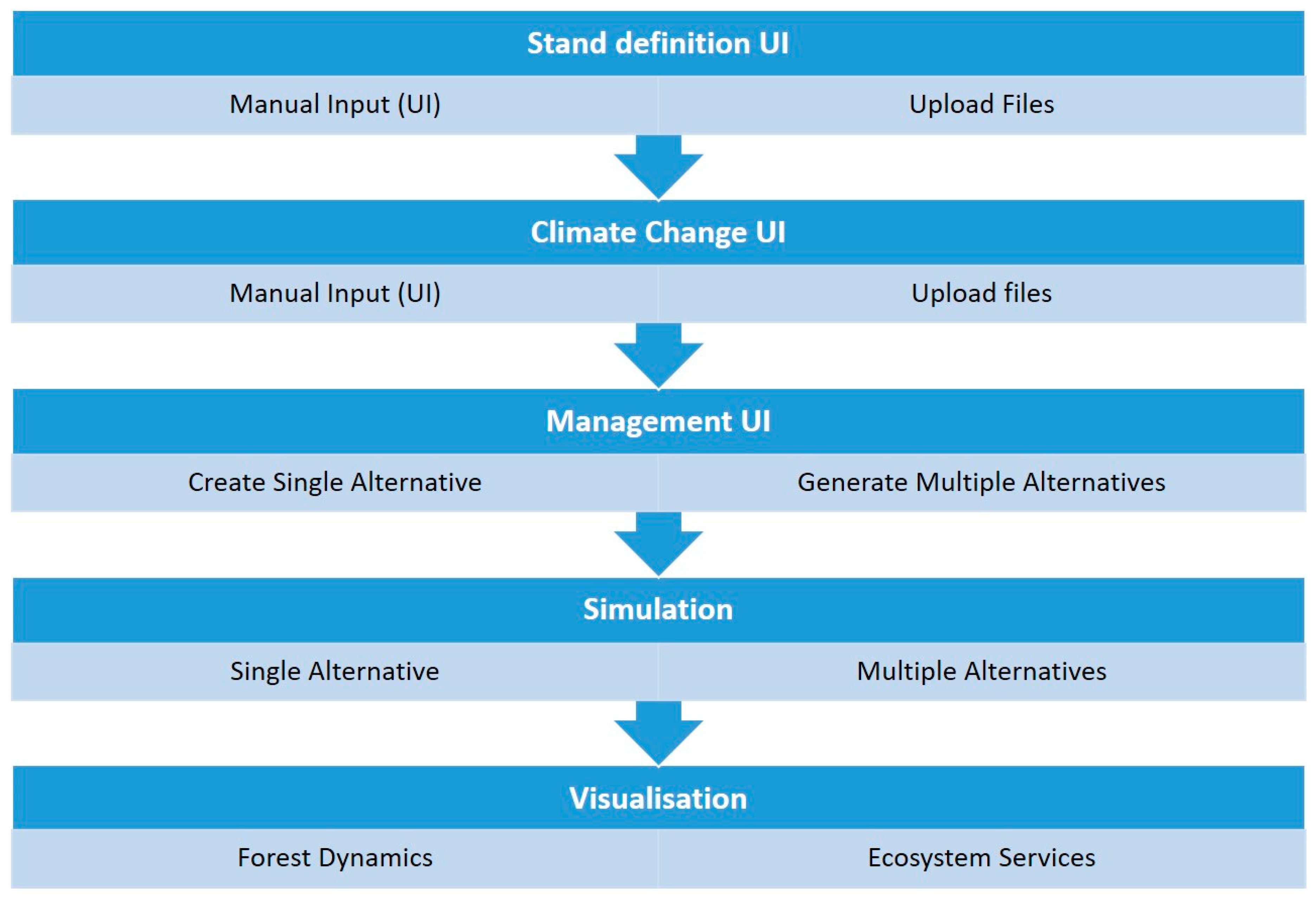

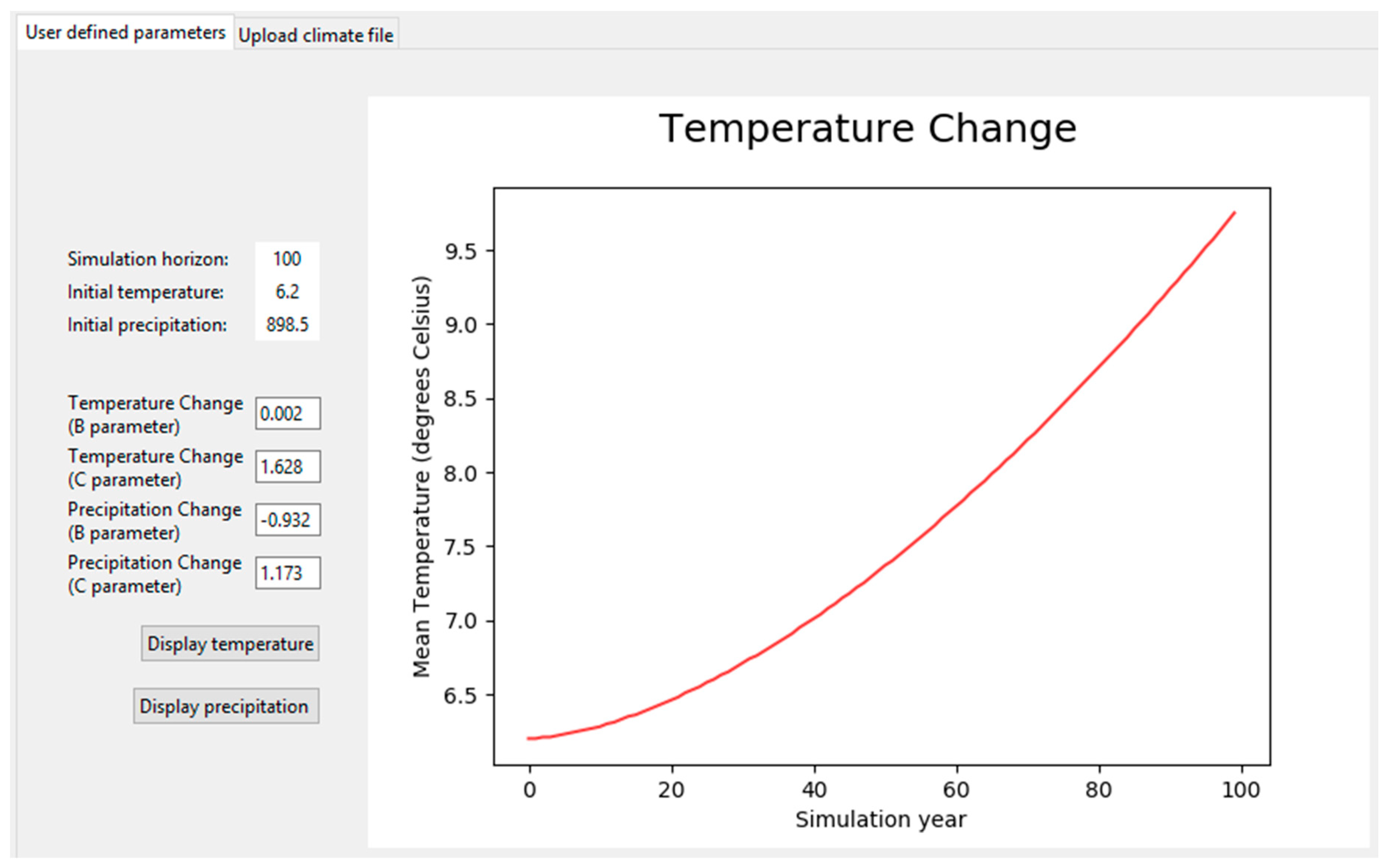
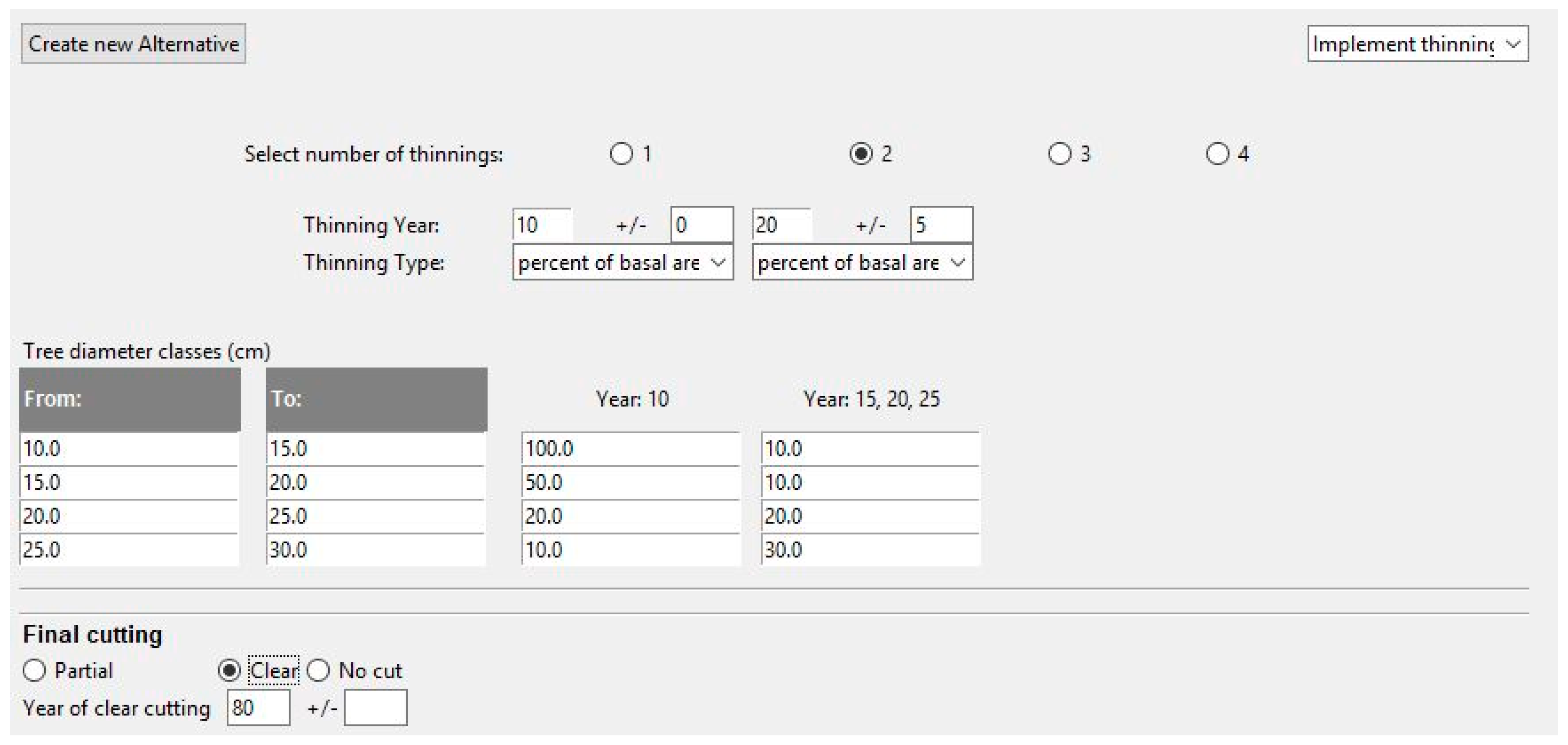
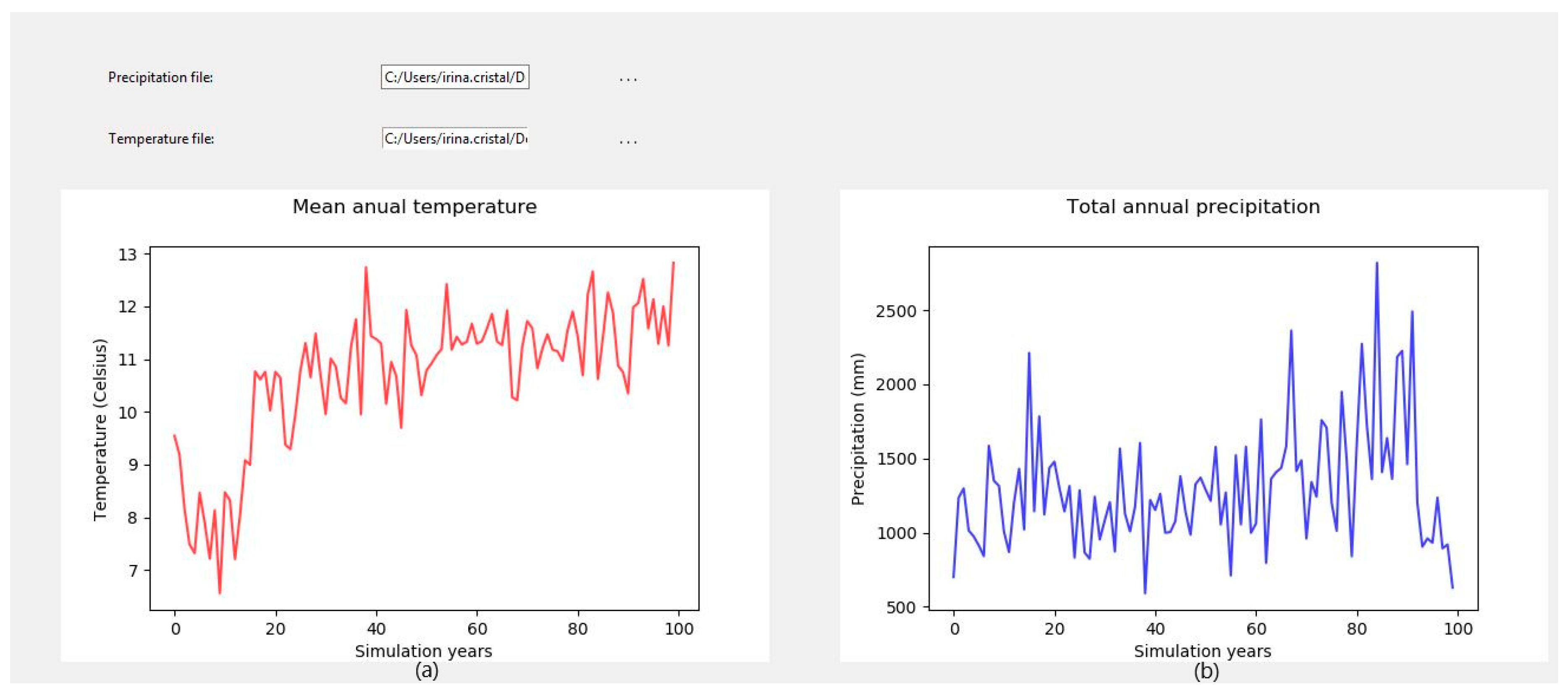
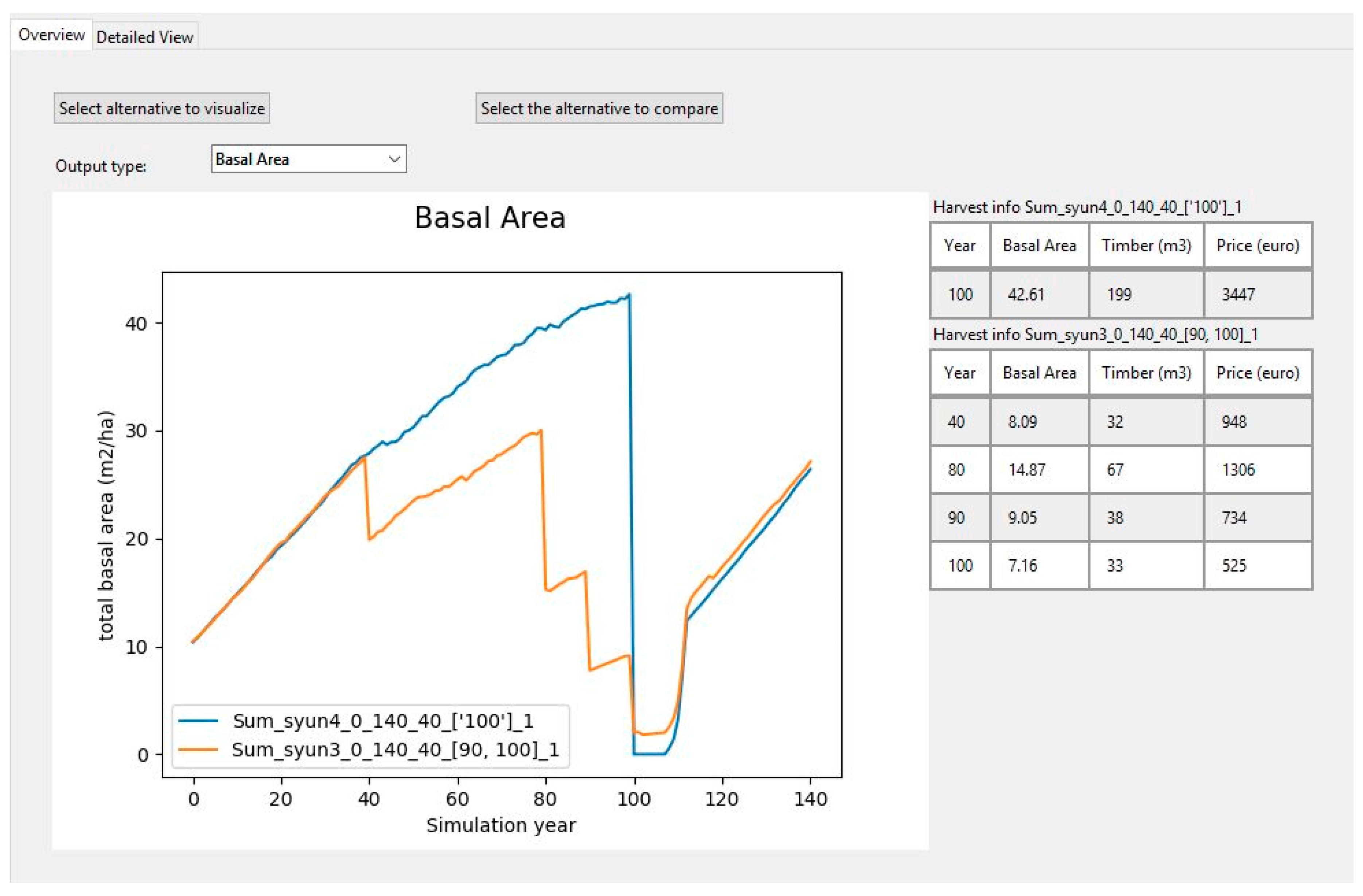
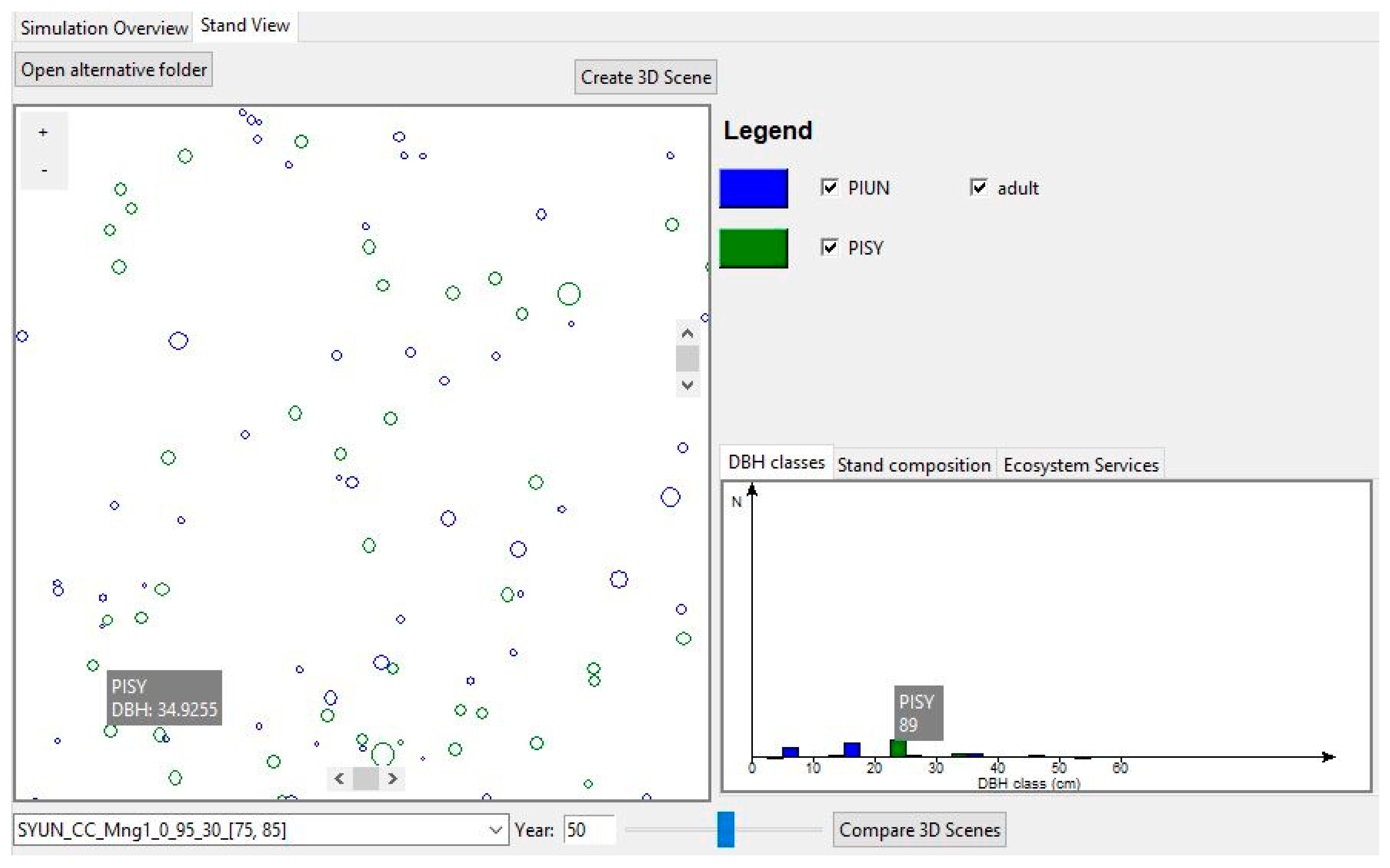
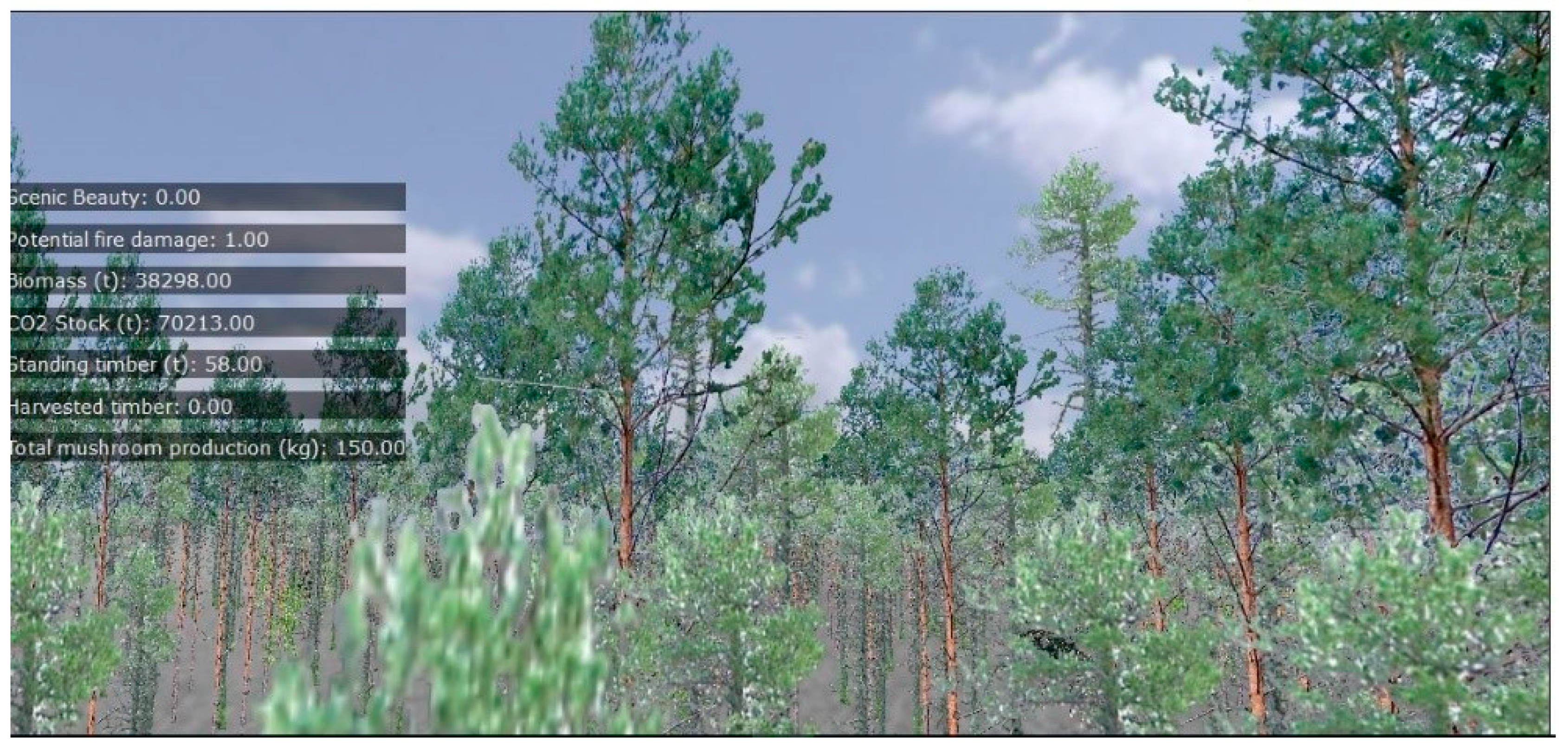
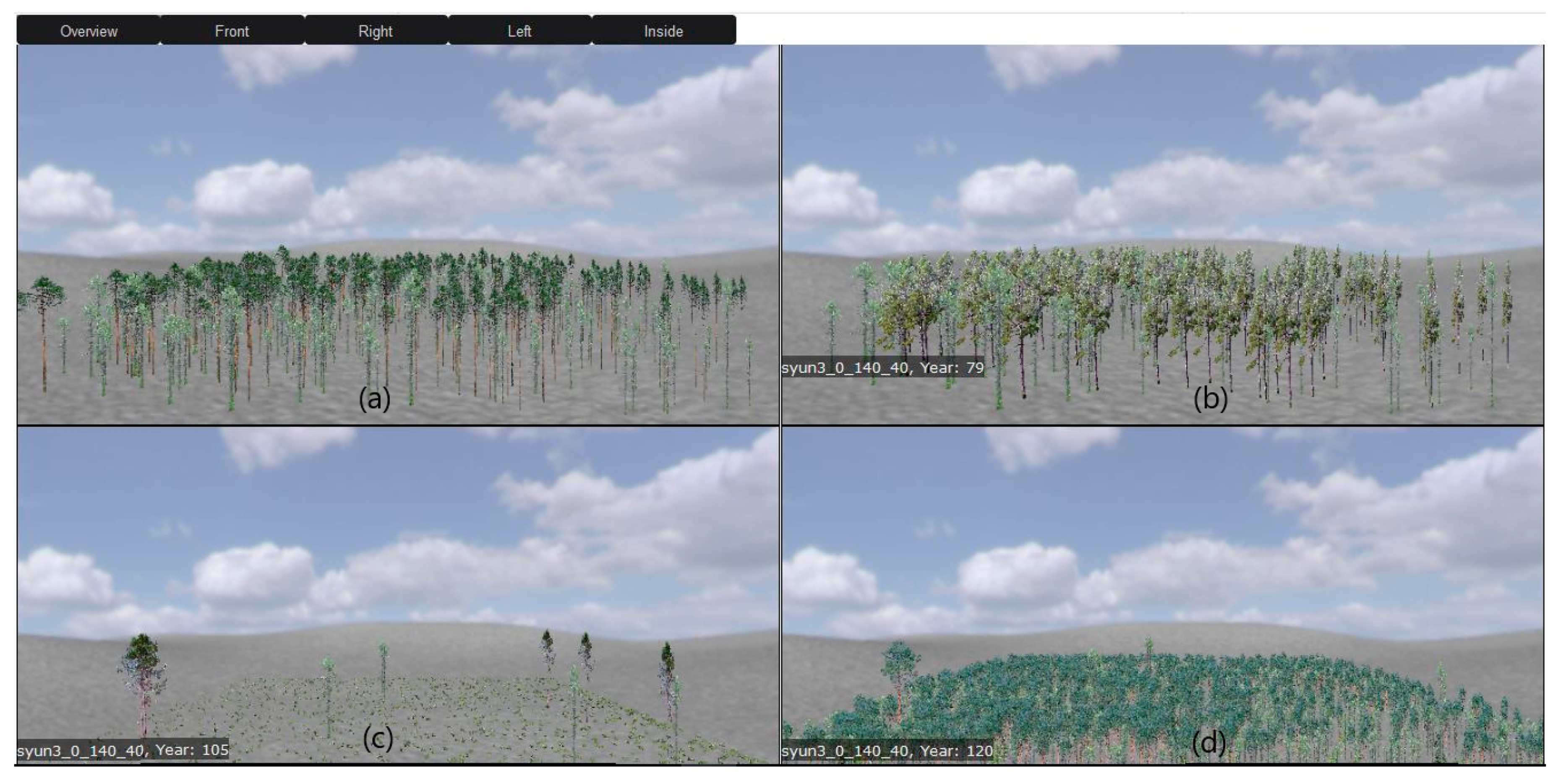
| Ecosystem Service | Description | Author |
|---|---|---|
| Provisioning Services | ||
| Biomass production | Above- and below-ground biomass, expressed by roots, stem, branches, and foliage of the trees. | Ruiz-Peinado et al., (2011) [7] |
| Timber production | Volume of harvested timber, derived from the stem biomass and wood density at 12% humidity | Catalan Guide for Forest Species [54] |
| Mushroom production | Amount of total, edible, and marketed mushrooms, in kg per hectare | De-Miguel et al. (2014) [55] |
| Regulating and Maintenance Services and Indicators | ||
| Carbon sequestration | Amount of sequestrated carbon by the tree biomass | Ruiz-Peinado et al. (2011) [7] |
| Forest fire prevention indicator | Potential fire damage, derived from Spanish forest inventories from plots affected by fire. | González-Olabarria et al. (2005) [38] |
| Snow and wind damage prevention indicator | Stand-level models for Pinus sylvestris and Pinus uncinata, describing the snow and wind damage severity based on data from the national forest inventory. | Martín-Alcón et al. (2010) [56] |
| Erosion protection indicator | Stand-level models for all the species in Catalonia, based on data from national forest inventory describing the probability of surface erosion occurrence. Used as an indicator of the erosion protection class defined by the Common International Classification of Ecosystem Services (CICES). | Selkimäki et al. (2012) [57] |
| Cultural Services | ||
| Scenic beauty | The aesthetic value of the forest, based on 259 evaluations of perceptual preference of pictures and 3D scenes. | Blasco et al. (2009) [58] |
| Auxiliary Models | ||
| Timber value | Economical value of timber, expressed in relation to roadside timber price, felling cost, and transportation cost | Solano et al. (2007) [59] |
| Maximum shrub coverage | Maximum response models relating maximum understory shrub cover with stand basal area and elevation for different dominant canopy species, using data from the Spanish National Forest Inventory | Coll et al. (2010) [60] |
| System Modules | Basic Steps | Alternative Path |
|---|---|---|
| Data input |
| Upload tab delimited files containing stand initial conditions and stand composition |
| Provide precipitation and temperature change parameters | |
| Management |
| Proceed without management alternatives |
| Simulation |
| |
| 2D visualization |
| |
| ||
| 3D visualization |
|
| DBH Class | P. sylvestris | P. uncinata |
|---|---|---|
| 0–10 | 127 | 0 |
| 11–15 | 0 | 14 |
| 16–20 | 56 | 0 |
| 21–25 | 0 | 14 |
| 26–30 | 14 | 0 |
| Latitude (degrees) | AVG Precipitation (mm) | AVG Temperature (°C) | Slope (%) | Distance from Road (m) | Altitude (m) | Aspect (degrees) |
|---|---|---|---|---|---|---|
| 42.0 | 900 | 10 | 27.5 | 0 | 1200 | 260 |
| Harvest Type | Year | Intensity (%Basal Area) |
|---|---|---|
| Alternative 1 | ||
| Thinning | 40 | 30 |
| Preparatory cut | 80 | 50 |
| Seed cut | 90 | 50 |
| Final cut | 100 | 90 |
| Alternative 2 | ||
| Clearcut | 120 | 100 |
© 2019 by the authors. Licensee MDPI, Basel, Switzerland. This article is an open access article distributed under the terms and conditions of the Creative Commons Attribution (CC BY) license (http://creativecommons.org/licenses/by/4.0/).
Share and Cite
Cristal, I.; Ameztegui, A.; González-Olabarria, J.R.; Garcia-Gonzalo, J. A Decision Support Tool for Assessing the Impact of Climate Change on Multiple Ecosystem Services. Forests 2019, 10, 440. https://doi.org/10.3390/f10050440
Cristal I, Ameztegui A, González-Olabarria JR, Garcia-Gonzalo J. A Decision Support Tool for Assessing the Impact of Climate Change on Multiple Ecosystem Services. Forests. 2019; 10(5):440. https://doi.org/10.3390/f10050440
Chicago/Turabian StyleCristal, Irina, Aitor Ameztegui, Jose Ramon González-Olabarria, and Jordi Garcia-Gonzalo. 2019. "A Decision Support Tool for Assessing the Impact of Climate Change on Multiple Ecosystem Services" Forests 10, no. 5: 440. https://doi.org/10.3390/f10050440
APA StyleCristal, I., Ameztegui, A., González-Olabarria, J. R., & Garcia-Gonzalo, J. (2019). A Decision Support Tool for Assessing the Impact of Climate Change on Multiple Ecosystem Services. Forests, 10(5), 440. https://doi.org/10.3390/f10050440







